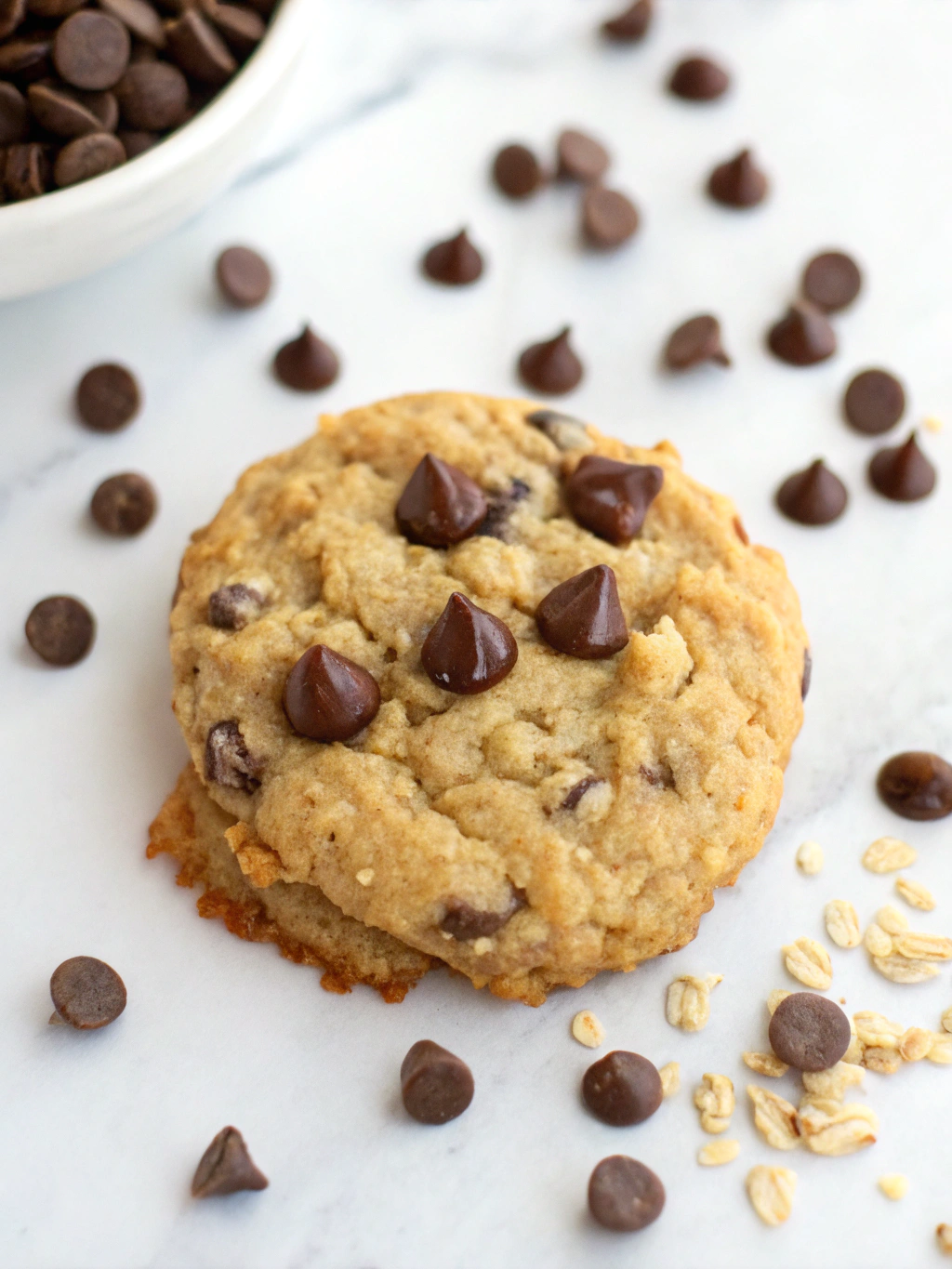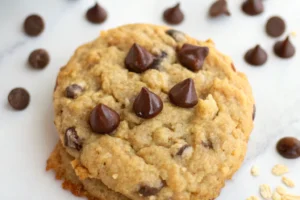If you’re searching for an oatmeal chocolate chip cookie recipe that balances chewiness, sweetness, and just the right amount of crunch, you’ve found it. This recipe has been tested, tweaked, and perfected to deliver cookies that stay soft for days—if they last that long. Whether you’re baking for a crowd or just satisfying a late-night craving, this is the only recipe you’ll need.

Why This Oatmeal Chocolate Chip Cookie Recipe Works
The science behind perfect oatmeal chocolate chip cookies involves understanding how ingredients interact at each stage of baking. Unlike standard chocolate chip cookies, the addition of oats introduces new variables that can make or break your batch.
Old-fashioned oats act as the structural backbone, absorbing just enough moisture to create chew without becoming dense. When compared to quick oats, which tend to disappear into the dough, old-fashioned oats maintain their integrity while softening to the perfect texture. The flake size matters too – larger flakes create more distinct oat layers in each bite.
The sugar combination isn’t arbitrary. Brown sugar’s molasses content attracts and holds moisture differently than white sugar. This dual-sugar system creates cookies that stay soft for days while still achieving that desirable crisp edge. The ratio we use (2:1 brown to white) has been tested against numerous variations to find the ideal balance.
Chilling serves multiple purposes beyond preventing spread. During this rest period, the flour fully hydrates, resulting in more even baking. The fats solidify, which slows melting in the oven for better texture control. Perhaps most importantly, this downtime allows flavors to meld – you’ll notice deeper caramel notes in chilled dough cookies.
Ingredients You’ll Need (And Why They Matter)
Every ingredient in this oatmeal chocolate chip cookie recipe serves a specific purpose. Understanding these roles helps when considering substitutions or troubleshooting issues.
The Fat Component
Unsalted butter provides the ideal fat base for several reasons:
- Its water content (about 18%) creates steam during baking, contributing to lift
- The milk solids brown during baking, adding complex flavor notes
- It creams perfectly with sugar to create air pockets for texture
While margarine or shortening can substitute in a pinch, they’ll alter both texture and flavor significantly.
Sugar Science
The combination of sugars works synergistically:
- Brown sugar (light or dark): Adds moisture, chewiness, and caramel notes
- Granulated sugar: Promotes spread and crisp edges
- The 2:1 ratio ensures neither quality overpowers the other
For those monitoring sugar intake, our baking substitutions guide offers alternative sweetener options.
Eggs and Binding
Large eggs (about 50g each) provide:
- Structure through protein coagulation during baking
- Emulsification to keep fats and liquids combined
- Additional moisture that interacts with the oats
Room temperature eggs incorporate more evenly than cold ones straight from the fridge.
Flour Fundamentals
All-purpose flour offers the ideal protein content (10-12%) for these cookies:
- Enough gluten to provide structure without becoming tough
- Neutral flavor that lets other ingredients shine
- Consistent results across different brands
For gluten-free alternatives, see our substitution guide for tested variations.
Oat Options
Old-fashioned rolled oats (not instant or steel-cut) are essential because:
- Their thickness stands up to mixing and baking
- They absorb liquid at the perfect rate for chewiness
- The flakes create pleasant texture contrasts
Quick oats will make your cookies dense and pasty – not the desired outcome.
Chocolate Considerations
Semi-sweet chocolate chips (45-60% cacao) balance the oats’ earthiness:
- Their slight bitterness counters the sweetness
- The higher melting point prevents complete disintegration
- Standard chip size distributes evenly throughout
Feel free to experiment with chunks or different cacao percentages.
Step-by-Step Instructions (With Pro Techniques)
Prepping the Dough Like a Pastry Chef
Creaming butter and sugars isn’t just mixing – it’s mechanical leavening. For optimal results:
- Use room temperature butter (65°F/18°C) – cool but yields to pressure
- Beat for a full 3 minutes until noticeably lighter in color
- Scrape the bowl halfway through to ensure even incorporation
- Add eggs one at a time, waiting until each fully emulsifies
This process creates tiny air pockets that expand during baking for lift.
The Art of Dry Ingredient Incorporation
Whisking dry ingredients first serves multiple purposes:
- Evenly distributes leavening agents
- Aerates the flour for lighter texture
- Prevents overmixing when combining with wet ingredients
When adding to the wet mixture:
- Mix on low speed just until no dry patches remain
- Fold in oats and chips by hand to prevent breakage
- Avoid overworking the dough to prevent gluten development
The Critical Chill Phase
Refrigeration transforms your dough in several ways:
- Hydration: Flour fully absorbs liquids for consistent texture
- Flavor development: Enzymes break down starches into sugars
- Texture control: Solidified fats melt slower during baking
- Spread prevention: Chilled dough holds its shape better
For best results:
- Chill for minimum 30 minutes, up to 72 hours
- Cover tightly to prevent drying
- Let sit at room temp for 10 minutes before scooping if very firm
Baking for Perfect Results Every Time
Oven variables dramatically affect outcomes:
- Preheat thoroughly – 20-30 minutes for even heat
- Use an oven thermometer to verify temperature
- Position racks in center for balanced heat circulation
During baking:
- Use parchment or silicone mats – grease promotes spreading
- Rotate pans halfway for even browning
- Watch for golden edges with slightly underdone centers
- Remember carryover cooking – they’ll firm up while cooling
Common Mistakes (And How to Avoid Them)
After testing hundreds of batches, these are the most frequent issues and their solutions:
Texture Troubleshooting
Problem: Cookies spread too thin
- Butter too warm when creaming
- Insufficient chilling time
- Overcrowded baking sheet
- Old baking soda
Solutions:
- Chill dough longer (up to overnight)
- Check butter temperature (should leave fingerprint but not sink)
- Replace leaveners every 6 months
- Bake in smaller batches with proper spacing
Problem: Cookies too cakey
- Too much flour (measuring error)
- Overmixing after adding flour
- Eggs too large or extra egg added
Solutions:
- Measure flour by weight or spoon-and-level method
- Mix just until combined after adding dry ingredients
- Use large eggs (not extra-large) and measure carefully
Flavor Fixes
Problem: Cookies taste bland
- Not enough salt
- Low-quality vanilla
- Stale ingredients
Solutions:
- Use pure vanilla extract (not imitation)
- Try a pinch of flaky salt on top before baking
- Check expiration dates on baking soda/powder
Storage Solutions
Problem: Cookies get hard next day
- Overbaking initially
- Improper storage
- Low humidity environment
Solutions:
- Store in airtight container with slice of bread
- Underbake slightly (they’ll firm up while cooling)
- Microwave for 5-10 seconds to refresh
FAQs
Can I make these cookies gluten-free?
Absolutely. Substitute the all-purpose flour with a 1:1 gluten-free blend that contains xanthan gum. The texture will be slightly more delicate, but still delicious. For tested flour alternatives, see our substitution guide.
Why do my cookies bake unevenly?
Oven hot spots are the usual culprit. Try rotating your baking sheet halfway through baking. Also ensure your dough balls are uniform in size – using a cookie scoop helps tremendously. If problems persist, consider an oven thermometer to check for temperature accuracy.
Can I reduce the sugar without ruining texture?
You can reduce by up to 25% with minimal texture impact, though cookies will be less crisp. For greater reductions, you’ll need to adjust other liquids to compensate. Sugar provides more than just sweetness – it affects spread, browning, and moisture retention.
How do I get thicker cookies?
Three key techniques: 1) Chill dough thoroughly, 2) Use cooler oven temperature (325°F) for slightly longer bake time, 3) Press dough balls down slightly before baking rather than leaving them perfectly round.
Can I add nuts or other mix-ins?
Certainly! Walnuts, pecans, or shredded coconut make excellent additions. Keep total add-ins to about 2 cups maximum to maintain proper dough structure. Toast nuts first for deeper flavor.
Why do you recommend semi-sweet over milk chocolate?
The slight bitterness of semi-sweet (45-60% cacao) balances the sweetness of the dough and complements the earthy oats. Milk chocolate can make the cookies overwhelmingly sweet. That said, personal preference rules – use what you love!
Final Thoughts
Once you try this oatmeal chocolate chip cookie recipe, you’ll understand why it’s a keeper. The texture, the flavor, the way they stay soft for days—everything just works. Need more dessert inspiration? Contact us for custom recipe requests!
Meta Title
Best Oatmeal Chocolate Chip Cookie Recipe – Soft & Chewy!
Meta Description
This oatmeal chocolate chip cookie recipe delivers perfect cookies every time. Soft, chewy, and packed with chocolate—bake a batch today!
Focus Keyphrase
oatmeal chocolate chip cookie recipe
Excerpt
The ultimate oatmeal chocolate chip cookie recipe—thick, chewy, and loaded with chocolate. Follow these steps for bakery-worthy results.
Tags
cookies, oatmeal cookies, chocolate chip cookies, baking, dessert recipes
Print
The Best Oatmeal Chocolate Chip Cookie Recipe You’ll Ever Make
- Total Time: 27 minutes
Description
These oatmeal chocolate chip cookies are perfectly soft, chewy, and loaded with chocolate! A foolproof recipe that’s easy to make and always a crowd-pleaser. Bake a batch today—they won’t last long! 😍
Ingredients
-
1 cup (2 sticks) unsalted butter, softened
-
1 cup packed brown sugar
-
½ cup granulated sugar
-
2 large eggs
-
2 tsp vanilla extract
-
1 ½ cups all-purpose flour
-
1 tsp baking soda
-
½ tsp salt
-
3 cups old-fashioned oats
-
1 ½ cups semi-sweet chocolate chips
Instructions
1️⃣ Cream butter & sugars – Beat butter, brown sugar, and granulated sugar until light and fluffy (3 mins).
2️⃣ Add eggs & vanilla – Mix in eggs one at a time, then vanilla.
3️⃣ Combine dry ingredients – Whisk flour, baking soda, and salt, then mix into wet ingredients.
4️⃣ Fold in oats & chocolate chips – Stir until just combined.
5️⃣ Chill dough – Cover and refrigerate for 30 mins (or up to 24 hrs).
6️⃣ Bake – Preheat oven to 350°F (175°C). Scoop 2-tbsp dough balls onto parchment-lined sheets, spacing 2″ apart. Bake 10-12 mins until edges are golden but centers are soft.
7️⃣ Cool – Let sit on baking sheet for 5 mins before transferring to a rack.
- Prep Time: 15 mins
- Cook Time: 12 mins
Nutrition
- Serving Size: 24 cookies
- Calories: ~180 kcal